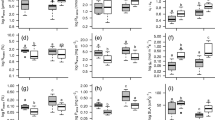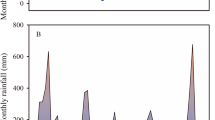Abstract
Key message
The xylem structure of the petiole and twig revealed in this study increase our knowledge about mistletoe and host function and their interaction.
Abstract
Although transpiration and photosynthesis relationships between mistletoes and their hosts have been studied extensively, only a few studies have been performed on their comparative anatomical structures. To our knowledge, no studies have focused on comparisons between the petiole and twig xylem structures of mistletoe and its host, although xylem structure is closely connected to tree physiology. In this study, the xylem structure and hydraulic conductivity of petioles and current-year twigs of the mistletoe Loranthus europaeus Jacq. and its host Quercus pubescens Willd. were measured. It was found that the petiole conduit lumen area, xylem area, and xylem-to-cross-sectional area ratio were, respectively, 1.4, 6.2, and 4.4 times higher in Quercus compared to Loranthus. The anatomical differences in xylem between both species were more pronounced in twigs than in petioles. Although the studied petiole conduit traits differed between Quercus and Loranthus, specific hydraulic conductivities were similar in both species. The similar specific hydraulic conductivities for both water competing species indicate that Loranthus and Quercus reach the same transpiration rates under good water supply conditions and under similar leaf water potential. The narrower conduits in Loranthus could make the xylem of this hemiparasite well adapted to withstand a higher water potential gradient without cavitation. Nevertheless, further studies are needed to define the anatomical and morphological traits involved in xylem cavitation in mistletoe, traits which could provide more information about the function and survival of mistletoe under conditions of higher water potential gradient.


Similar content being viewed by others
References
Anfodillo T, Carraro V, Carrer M, Fior C, Rossi S (2006) Convergent tapering of xylem conduits in different woody species. New Phytol 169:279–290
Bell T, Adams M (2011) Attack on all fronts: functional relationships between aerial and root parasitic plants and their woody hosts and consequences for ecosystems. Tree Physiol 31:3–15
Bhandari NN, Mukerji KG (1993) The haustorium. Research Studies Press Ltd., New York
Brodribb TJ, Bienaimé D, Marmottant P (2016) Revealing catastrophic failure of leaf networks under stress. PNAS 113:4865–4869
Buček A, Lacina J, Laštůvka Z (2006) Pannonian steppe grasslands in Moravia. Veronica 20:1–40
Čermák J, Jiménez SM, González-Rodríguez AM, Morales D (2002) Laurel forests in Tenerife, Canary Islands. Trees 16:538–546
Cochard H, Tyree MT (1990) Xylem dysfunction in Quercus: vessel sizes, tyloses, cavitation and seasonal changes in embolism. Tree Physiol 6:393–407
Cochard H, Damour G, Bodet C, Tharwat I, Poirier M, Ameglio T (2005) Evaluation of a new centrifuge technique for rapid genera- tion of xylem vulnerability curves. Physiol Plant 124:410–418
Cocoletzi E, Angeles G, Ceccantini G, Patrón A, Ornelas JF (2016) Bidirectional anatomical effects in a mistletoe-host relationship: Psittacanthus schiedeanus mistletoe and its hosts Liquidambar styraciflua and Quercus germana. Am J Bot 103:986–997
Coder KD (2008) American mistletoe (Phoradendron serotinum var. serotinum) infection in trees. Tree Health Ser WSFNR 08–25, Warnell School, University of Georgia, USA
Coomes DA, Heathcote S, Godfrey ER, Shepherd JJ, Sack L (2008) Scaling of xylem vessels and veins within the leaves of oak species. Biol Lett 4:302–306
Dobbertin M, Hilker N, Rebetez M, Zimmermann NE, Wohlgemoth T, Rigling A (2005) The upward shift in altitude of pine mistletoe (Viscum album ssp. austriacum) in Switzerland the result of climate warming? Int J Biometeorol 50:40–47
Doležal J, Lehečková E, Sohar K, Altman J (2016) Oak decline induced by mistletoe, competition and climate change: a case study from central Europe. Preslia 88:323–346
Eliáš P, Huzulák J (1978) Contribution to the study of water relationships between hemiparasite (Loranthus europaeus L.) and its host (Quercus cerris L.). Acta Bot Slov Acad Sci Slovacae 4:265–276
Escher P, Eiblmeier M, Hetzger I, Rennenberg H (2004) Seasonal and spatial variation of carbohydrates in mistletoes (Viscum album) and the xylem sap of its hosts (Populus x euamericana and Abies alba). Physiol Plant 120:212–219
Ewers FW, Fisher JB (1989) Variation in vessel length and diameter in stems of six tropical and subtropical lianas. Am J Bot 6:1452–1459
Garkoti SC, Akoijam SB, Singh SP (2002) Ecology of water relations between mistletoe (Taxillus vestitus) and its host oak (Quercus floribunda). Trop Ecol 43:243–249
Gebauer R, Volařík D (2013) Root hydraulic conductivity and vessel structure modification with increasing soil depth of two oak species: Quercus pubescens and Quercus robur. Trees 27:523–531
Gebauer R, Volařík D, Urban J (2012) Quercus pubescens and its hemiparasite Loranthus europaeus: nutrient dynamics of leaves and twigs. Acta Physiol Plant 34:1801–1809
Gebauer R, Volařík D, Urban J (2018) Seasonal variations of sulphur, phosphorus and magnesium in the leaves and current-year twigs of hemiparasitic mistletoe Loranthus europaeus Jacq. and its host Quercus pubescens Willd. J For Sci 64:66–73
Glatzel G (1983) Mineral nutrition and water relations of hemiparasitic mistletoes: a question of partitioning. Experiments with Loranthus europaeus on Quercus petraea and Quercus robur. Oecologia 56:193–201
Glatzel G, Geils BW (2009) Mistletoe ecophysiology: host–parasite interactions. Botany 87:10–15
Hacke UG, Sauter JJ (1995) Vulnerability of xylem to embolism in relation to leaf water potential and stomatal conductance in Fagus sylvatica f. purpurea and Populus balsamifera. J Exp Bot 46:1177–1183
Hacke UG, Sperry JS, Pittermann J (2005) Efficiency versus safety tradeoffs for water conduction in angiosperm vessles versus gymnosperm tracheids. In: Holbrook NM, Zwieniecki MA (eds) Vascular transport in plants. Elsevier Academic Press, New York, pp 333–354
Hacke UG, Sperry JS, Wheeler JK, Castro L (2006) Scaling of angiosperm xylem structure with safety and efficiency. Tree Physiol 26:689–701
Hacke UG, Jacobsen AL, Pratt RB (2009) Xylem function of arid-land shrubs from California, USA: an ecological and evolutionary analysis. Plant Cell Environ 32:1324–1333
Hargrave KR, Kolb KJ, Ewers FW, Davis SD (1994) Conduit diameter and drought-induced embolism in Salvia mellifera Greene (Labiatae). New Phytol 126:695–705
Hietz P, Rosner S, Sorz J, Mayr S (2008) Comparison of methods to quantify loss of hydraulic conductivity in Norway spruce. Ann For Sci 65:502
Jacobsen AL, Pratt RB (2018) Going with the flow: Structural determinants of vascular tissue transport efficiency and safety. Plant Cell Environ 41:2715–2717
Johnson DM, Wortemann R, McCulloh KA, Jordan-Meille L, Ward E, Warren JM, Palmroth S, Domec JC (2016) A test of the hydraulic vulnerability segmentation hypothesis in angiosperm and conifer tree species. Tree Physiol 36:983–993
Kuijt J (1969) The biology of parasitic flowering plants. University of California Press, Berkeley
Lens F, Sperry JS, Christman MA, Choat B, Rabaey D, Jansen S (2011) Testing hypotheses that link wood anatomy to cavitation resistance and hydraulic conductivity in the genus Acer. New Phytol 190:709–723
Marshall JD, Dawson TE, Ehleringer JR (1994) Integrated nitrogen, carbon and water relations of a xylem-tapping mistletoe following nitrogen fertilization of the host. Oecologia 100:430–438
Martre P, Durand JL, Cochard H (2000) Changes in axial hydraulic conductivity along elongating leaf blades in relation to xylem maturation in tall feste. New Phytol 146:235–247
Matula R, Svátek M, Pálková M, Volařík D, Vrška T (2015) Mistletoe infection in an oak forest is influenced by competition and host size. PLoS One 10:e0127055
Mrad A, Domec JC, Huang CW, Lens F, Katul G (2018) A network model links wood anatomy to xylem tissue hydraulic behaviour and vulnerability to cavitation. Plant Cell Environ 41:2718–2730
Pinheiro J, Bates D, DebRoy S, Sarkar D, R Core Team (2018) _nlme: linear and nonlinear mixed effects models. R package version 3.1–137. https://CRAN.R-project.org/package=nlme>. Accessed 20 Apr 2018
Pivovaroff AL, Sack L, Santiago LS (2014) Coordination of stem and leaf hydraulic conductance in southern California shrubs: a test of the hydraulic segmentation hypothesis. New Phytol 203:842–850
Plavcová L, Jansen S, Klepsch M, Hacke UG (2013) Nobody’s perfect: can irregularities in pit structure influence vulnerability to cavitation. Front Plant Sci 4:453
Plichta R, Urban J, Gebauer R, Dvořák M, Ďurkovič J (2016) Long-term impact of Ophiostoma novo-ulmi on leaf traits and transpiration of branches in the Dutch elm hybrid “Dodoens”. Tree Physiol 36:335–344
R Core Team (2018) R: a language and environment for statistical computing. R Foundation for Statistical Computing, Vienna, Austria. https://www.R-project.org/. Accessed 20 Apr 2018
Rigling A, Eilmann B, Koechli R, Dobbertin M (2010) Mistletoe-induced crown degradation in Scots pine in a xeric environment. Tree Physiol 30:845–852
Sack L, Holbrook NM (2006) Leaf hydraulics. Annu Rev Plant Biol 57:61–81
Schneider CA, Rasband WS, Eliceiri KW (2012) NIH image to ImageJ: 25 years of image analysis. Nat Methods 9:671–675
Schulze ED, Turner NC, Glatzel G (1984) Carbon, water and nutrient relations of two mistletoes and their hosts: a hypothesis. Plant Cell Environ 7:293–299
Sperry J, Hacke U, Pitterman J (2006) Size and function in conifer tracheids and angiosperm vessels. Am J Bot 93:1490–1500
Strong GL, Bannister P, Burritt D (2000) Are mistletoes shade plants? CO2 assimilation and chlorophyll fluorescence of temperate mistletoes and their hosts. Ann Bot Lond 85:511–519
Türe C, Böcük H, Aşan Z (2010) Nutritional relationships between hemi-parasitic mistletoe and some of its deciduous hosts in different habitats. Biologia 65:859–867
Tyree MT, Ewers FW (1991) The hydraulic architecture of trees and other woody plants. New Phytol 119:345–360
Tyree MT, Zimmermann MH (2002) Xylem structure and the ascent of sap, 2nd edn. Springer, Berlin
Tyree MT, Davis SD, Cochard H (1994) Biophysical perspectives of xylem evolution—is there a tradeoff of hydraulic efficiency for vulnerability to dysfunction? IAWA J 15:335–360
Urban J, Gebauer R, Nadezhdina N, Čermák J (2012) Transpiration and stomatal conductance of mistletoe (Loranthus europaeus) and its host plant, downy oak (Quercus pubescens). Biologia 67:917–926
Villar-Salvador P, Castro-Diez P, Perez-Rontome C, Montserrat-Marti C (1997) Stem xylem features in three Quercus (Fagaceae) species along a climatic gradient in NE Spain. Trees Struct Funct 12:90–96
Watson DM (2001) Mistletoe—a keystone resource in forests and woodlands worldwide. Annu Rev Ecol Evol Syst 32:219–249
Yang D, Goldstein G, Wang M, Zhang W, Wang A, Liu Y, Hao G (2017) Microenvironment in the canopy rivals the host tree water status in controlling sap flow of a mistletoe species. Tree Physiol 37:501–510
Zhang L, Copini P, Weemstra M, Sterck F (2016) Functional ratios among leaf, xylem and phloem areas in branches change with shade tolerance, but not with local light conditions, across temperate tree species. New Phytol 209:1566–1575
Zweifel R, Bangerter S, Rigling A, Sterck FJ (2012) Pine and mistletoes: how to live with a leak in the water flow and storage system? J Exp Bot 63:2565–2578
Acknowledgements
This work was supported by the Ministry of Culture of the Czech Republic (project Reg. no. DG18P02OVV027) and by the project ‘‘Indicators of Tree Vitality’’ (Reg. no. CZ.1.07/2.3.00/20.0265) co-financed by the European Social Fund and the Czech Republic and by the Ministry of Education, Youth and Sports of the Czech Republic.
Author information
Authors and Affiliations
Corresponding author
Ethics declarations
Conflict of interest
The authors declare that they have no conflict of interest.
Additional information
Communicated by Nardini.
Publisher’s Note
Springer Nature remains neutral with regard to jurisdictional claims in published maps and institutional affiliations.
Rights and permissions
About this article
Cite this article
Gebauer, R., Albrechtová, P., Plichta, R. et al. The comparative xylem structure and function of petioles and twigs of mistletoe Loranthus europaeus and its host Quercus pubescence. Trees 33, 933–942 (2019). https://doi.org/10.1007/s00468-019-01829-2
Received:
Accepted:
Published:
Issue Date:
DOI: https://doi.org/10.1007/s00468-019-01829-2




